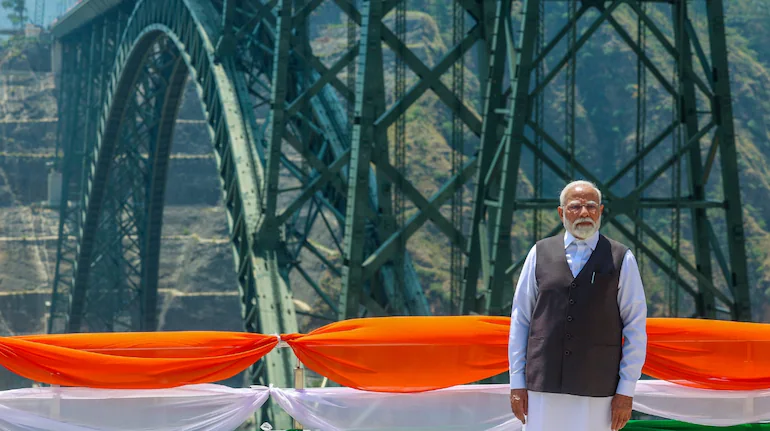In a landmark moment for Indian engineering and regional connectivity, Prime Minister Narendra Modi on Thursday inaugurated the Chenab Rail Bridge in Jammu and Kashmir — a monumental structure now officially recognized as the highest railway bridge in the world.
Towering 359 meters (1,178 feet) above the riverbed of the Chenab in the Reasi district, the steel arch bridge surpasses the height of the Eiffel Tower, setting a new global record in rail infrastructure. With a span of 1,315 meters, the bridge is a pivotal element of the Udhampur–Srinagar–Baramulla Rail Link (USBRL) project, designed to seamlessly connect the Kashmir Valley with the rest of India through a secure and all-weather rail corridor.
“This is not just a bridge; it is a symbol of a new era of connectivity and progress for Jammu and Kashmir,” Prime Minister Modi said at the inaugural ceremony, held amid tight security and national media presence. “Through this marvel, we are sending a message to the world: India can build where the world thinks it is impossible.”
An Engineering Triumph Amid Harsh Terrain
The Chenab Bridge, constructed by Indian Railways in collaboration with infrastructure firms like Afcons and Konkan Railway, has been lauded for its technological complexity and resilience. Built in a seismic-prone zone with extreme wind conditions and rugged terrain, the bridge’s arch was assembled using advanced cable crane technology, while steel piers were designed to withstand winds up to 260 km/h.
The structure incorporates blast-resistant features and corrosion-resistant materials, and is expected to endure for over 120 years — a critical consideration for a region historically hampered by geographic isolation and political volatility.
Railway Minister Ashwini Vaishnaw, present at the ceremony, called the bridge “a miracle of modern engineering, forged under the most challenging circumstances India’s railway system has ever faced.”
Kashmir’s First Cable-Stayed Rail Bridge Also Unveiled
In a complementary move, PM Modi also inaugurated the Anji Khad Bridge, India’s first cable-stayed railway bridge, further bolstering the region’s rail infrastructure. Together, these developments mark a new chapter in northern India’s economic integration and tourism development.
Local communities, long reliant on narrow roadways and unpredictable weather, have welcomed the project with optimism. The new rail link is expected to dramatically reduce travel time between Udhampur and Srinagar while facilitating trade, job creation, and year-round accessibility.
Geopolitical and Economic Implications
Strategically, the Chenab Bridge is more than an engineering feat; it is a geopolitical signal. At a time when India is investing heavily in border-area infrastructure, especially in regions near China and Pakistan, the completion of such a high-profile project in Jammu and Kashmir sends a strong message about national commitment to development and integration.
Economically, the bridge is expected to accelerate the tourism and transport sectors in the valley, while offering a faster, more secure supply line for both civilian and defense purposes.
“This is a historic day not only for Jammu and Kashmir but for all of India,” Modi declared. “This bridge is the pride of our engineers and a promise to the future.”


